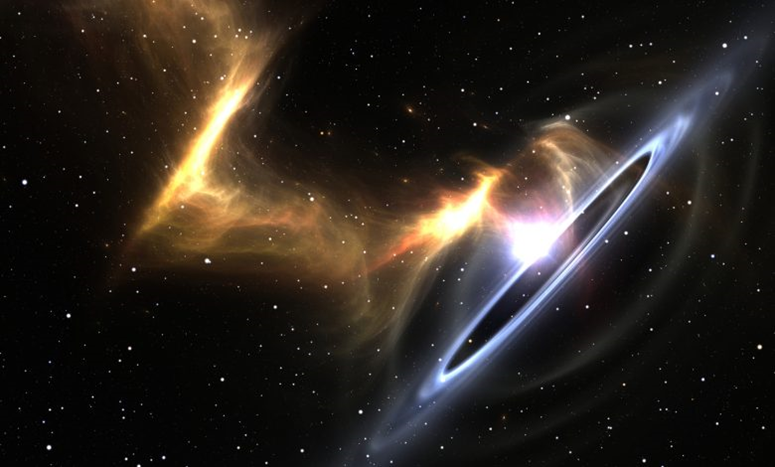“It was a magical moment.” The noise emitted by black holes is heard for the first time

After a quarter-century of tracking them, astronomers have finally detected the gravitational waves generated by black holes millions to billions of times more massive than the sun.
Scientists were finally able to detect the background noise emitted by the whirlwind of giant black holes, after trying for a quarter of a century to track it. And what made it possible to hear them for the first time is an unprecedented technique for detecting gravitational waves, which opens a "new window on the universe."
These results, announced Thursday, are the result of a large-scale collaboration of the world's largest radio telescopes, which were able to capture this vibration of the universe "with clock accuracy", which aroused the enthusiasm of the authors of the study, which was published simultaneously in more than one scientific journal.
Gravitational waves, the existence of which Einstein was the first to point out in 1916, and already observed a hundred years later, are tiny distortions in space-time, like ripples in water on the surface of a pond. These oscillations, which spread at the speed of light, are caused by violent cosmic events, such as the collision of two black holes.
It is remarkable that its signals are very weak, although they are caused by huge phenomena. In 2015, the gravitational-wave detectors LIGO (USA) and VIRGO (Europe) revolutionized astrophysics by detecting the sub-second flicker caused by collisions between stellar black holes ten times the mass of the Sun.
This time, a signal that lasts much longer appears to be a large-scale phenomenon monitored by a network of radio telescopes (from Europe, North America, India, Australia and China) of the International Pulsar Timing Array Association.
The astronomer at the Paris-BSL Observatory, Gilles Toro, who coordinated the work of the French side, explained that the matter is related to gravitational waves generated by black holes that are "more massive than the sun's mass by millions to billions of times."
'It was a magical moment'
To detect these waves, scientists used a new tool: pulsars from the Milky Way. These stars are characterized by the fact that their mass is equivalent to between one and two suns, compressed into a ball with a diameter of about ten kilometers.

These very small stars revolve around themselves at a high speed of up to 700 revolutions per second, as explained by the researcher at the French National Center for Scientific Research. This ultra-fast rotation produces magnetic radiation at the poles, similar to the rays of a beacon, that can be detected thanks to radio waves emitted from low frequencies.
At each rotation, the pulsars send out super regular "beeps", making them "amazing natural clocks", explains Luca Guimeau of the Laboratory of Physics and Chemistry for the Environment and Space (LPC2E) in Orleans, France.
And the scientists made a list of groups of pulsars through which they reached a "celestial web" in the zigzags of space-time.
They were able to measure a slight perturbation in the "ticking" of these stars, with "changes of less than a millionth of a second over more than 20 years," according to Antoine Potito of the Atomic Energy Agency.
It turns out that these delays are interconnected, and are a sign of "a disturbance common to all pulsars," according to Gil Toro, as he calls it. gravitational waves. "It was a magical moment," said Maura McLaughlin of the American "Pulsar Search Collaborator" during a press conference.
Like in a noisy restaurant
What is the source of these waves? The most likely hypothesis is that pairs of supermassive black holes, each larger than our solar system, are "ready to collide," explains Gilles Toro.
Antoine Potito likened it to two giants "turning around before merging", a dance that causes gravitational waves of "months to years" duration.
Michael Keith of the European Pulsar Timing Matrix compared this constant background noise to "a noisy restaurant with loads of people talking".
The measurements do not yet allow us to determine whether this noise indicates the presence of a few pairs of black holes, or the presence of a large group. Another hypothesis refers to the existence of a source in the very early ages of the universe, during which it witnessed what is called an inflationary stage.
And Gil Toro considered that this discovery opens a "new window on the universe." "We are adding a new set of information sources" that complement the research of "LIGO" and "Virgo" and operate on different wavelengths, according to Antoine Potito, which could clarify, in particular, the mystery of the formation of massive black holes.

However, in-depth studies are expected to be carried out within a year to enhance the strength of the discovery, and to ensure that this matter is "not a coincidence," as confirmed by the Paris Observatory, the National Center for Scientific Research, the Atomic Energy Authority, and the Universities of Orleans and "Paris City" in a statement.
Source : websites

